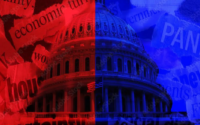Mental Health and the Economic Repercussions of COVID-19
Article by Georgia Dietz.
COVID-19 defined 2020 due to the mass health pandemic; however, the grim impact of COVID-19 on mental health has received less attention. Recent work has demonstrated the disparate economic effects of COVID-19 across income groups, where those of lower socioeconomic status face more difficulties with employment and food security. Such economic distress is likely to be followed by mental health concerns. Research from the Lowe explores COVID-19’s heterogeneous effects on mental health, paying particular attention to the dates when the lowest income groups report declines in mental health and the highest income groups experience improvements.
We employ mental health and employment data from the USC Center for Economic and Social Research’s Understanding Coronavirus in America database1 from March of 2020 to the end of 2020. Figures 1, 2 and 3 plot the fraction of individuals that experience psychological distress, depression, and anxiety, respectively, across income groups. The figures demonstrate that all income groups saw a substantial increase in the percent of individuals who report mental health problems during mid-March. Unsurprisingly, during that time period, the WHO and the Trump administration declared COVID-19 a pandemic, creating massive worries about future economic and health conditions. However, by late March (the first shaded region in the figures), the gap between the lowest income group and highest income group widened, where those of higher income report decreases in depression and anxiety and lower income groups report increases.
To investigate the dates where mental health gaps widen, we explore S&P 500 stock returns. Because stocks have been volatile and higher income groups are more likely to invest in the market, one could hypothesize that high income groups’ improvements in mental health could be related to stock market gains. Figure 4 plots the S&P 500 returns, where the shaded regions mark a disparate “mental health score” (i.e., the combined mental health factors of positive anxiety, positive depression, and mild to severe psychological distress had a very high gap between the high income and low income groups). For a majority of these dates, S&P 500 returns were trending positively. We note that only 19% of families with a combined income of 35K invest in the stock market, while 88% of families of families with an income of 100K+ invest. Thus, for these dates, high-income groups likely saw realized wealth gains from stock market participation while these gains didn’t exist at the same level for the lower income group. However, there are many dates marked without much stock market activity. Since lower income groups are less likely to own stocks, they may be less affected by stock volatility. Additionally, high income groups are unlikely to sell just on upward trends of the stock market as they may be holding for longer periods of time. S&P returns are likely not the driving force for the mental health gaps between the income groups.
Another economic indicator, perceived job loss, seems to better align with the dates where the mental health gap was prevalent. In periods where mental health improved for high income but fell for low income, employment tended to decrease and be unstable for low income earners, and rise for high income earners (see Figure 5). Overall, realized job loss was greater in 2020 for lower income groups than those of higher income. Fears of unemployment lead to financial insecurity, a well-established risk factor for psychiatric morbidity. Of particular importance is the link between job loss and health care. While normally unemployment anxiety would have an impact on workers, during COVID, it has an extra fear toll where people are worried of losing their health insurance. In August, the Economic Policy Institute found that in the past seven months of COVID-19 pandemic, over six million Americans lost health insurance that had been provided by their employer. Taking spouses and children into account, that number increases to 12 million Americans. Loss of employment and health care for low income earners who may have been already struggling would have been an additional mental health burden.
Another factor that potentially corresponded to mental health decreases for lower income earners was food insecurity. In times when the gap was particularly high, there were corresponding peaks showing low income individuals were particularly worried about running out of food (see Figure 6). For example, both September 15th through 20th and October 14th through 17th, showcase local maximums. Since the greater public became aware of COVID in mid-March, “numerous surveys have documented unprecedented levels of food insecurity that eclipse anything seen in recent decades in the United States, including during the Great Recession” with typical levels in the last 5 years around 11% to 12% (Wolfson and Leung). The average level during March and April of 2020? 38%. Low income earners grappling to make ends meet face a widening gap with higher earners who don’t feel the same pressure with food insecurity.
The negative effects associated with the economic downturn of the COVID-19 pandemic has induced poor mental health conditions for all Americans; however, those poor conditions are particularly pronounced for those Americans who are struggling to make ends meet. Did low-income earners struggle to put food on the table while high-income earners comfortably check their rising stock portfolios? While we cannot pin down the exact mechanism driving the gap in mental health concerns between income groups, there appears to be an association between the dates where the gap widens and the dates where employment improves for high-income individuals and the S&P returns increase. As the economic conditions of COVID-19 cause more unemployment and food insecurity, low-income earners will disproportionately feel the mental health effects.
Figure 4:
Figure 5:
Figure 6:
Figures 1, 2, and 3:


